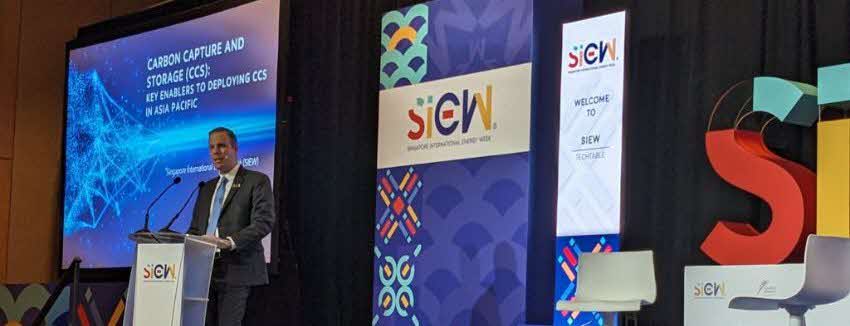ExxonMobil Low Carbon Solutions' Justin Oettmeier talks about carbon capture and storage and its role in the region's decarbonisation efforts.

At the SIEW TechTable session on "Key enablers to deploying CCS in Asia Pacific", Justin Oettmeier, Vice President of Technical Development, Asia Pacific, ExxonMobil Low Carbon Solutions, emphasised the pivotal role carbon capture and storage (CCS) plays in achieving our climate goals. CCS is a crucial technology, especially for hard-to-abate sectors such as industrial power generation and commercial transport.
Here, we distill three key insights from his presentation:
CCS needs to scale exponentially
Mr Oettmeier stressed that CCS must grow exponentially to meet the world's net-zero ambitions. As he put it, there is still "a lot of work to do" and "more progress is needed" when it comes to CCS. The current pace of global projects is at just 30 percent of what is needed to achieve the International Energy Agency's net zero 2050 scenario. By 2030, we require 1.2 billion tonnes of CCS capacity. By 2050, this rises to 6.2 billion.
As of September 2022, there are only about 30 commercial CCS projects operational worldwide, which capture and store an estimated 43 million tonnes of CO2 a year. The positive news is that project developers like ExxonMobil have announced ambitions to establish over 200 new capture facilities by 2030.
Still, this is not enough, said Mr Oettmeier. To achieve climate mitigation targets, he shared that the world needs about 2,000 large-scale CCS projects by 2050.
Opportunity to create a cross-border value chain in APAC
The diverse and unique markets in Asia Pacific, ranging from advanced economies with aggressive decarbonisation plans to emerging economies with vast CO2 storage potential, offer an opportunity to create a cross-border value chain. However, he cautioned that this endeavour is complex as it involves multiple countries and governments.
Enabling CCS through carbon capture, transportation and storage
Mr Oettmeier highlighted that the cost of carbon capture depends on the concentration of CO2 emissions. The lower the amount of CO2, the more expensive it is to extract, transport and store. To address this, a "hub" approach could help capture economies of scale. ExxonMobil is installing CCS services as part of a consortium in the US, with plans to replicate this in Asia.
For transportation, Mr Oettmeier said it is possible to reuse existing infrastructure, such as natural gas pipelines, to help reduce costs. On the shipping side, low-pressure shipping technology allows CO2 to be transported over longer distances. And floating storage and ejection units can help minimise development costs by offloading CO2 nearer to the source.
On the storage front, there are technologies that ensure adequate and safe storage of captured CO2. These methods involve reusing existing offshore infrastructure, improving storage efficiency through increased injection rates, and utilising natural geological barriers for added safety and effectiveness.
Mr Oettmeier concluded on an optimistic note, saying that with supportive policies, close government collaboration, and technological advancements to lower costs, CCS technologies hold "significant market potential". He expressed eagerness to work together, both publicly and privately, to accelerate CCS implementation towards a clean energy future.
Follow us on X (formerly Twitter) and Telegram to get the latest updates.